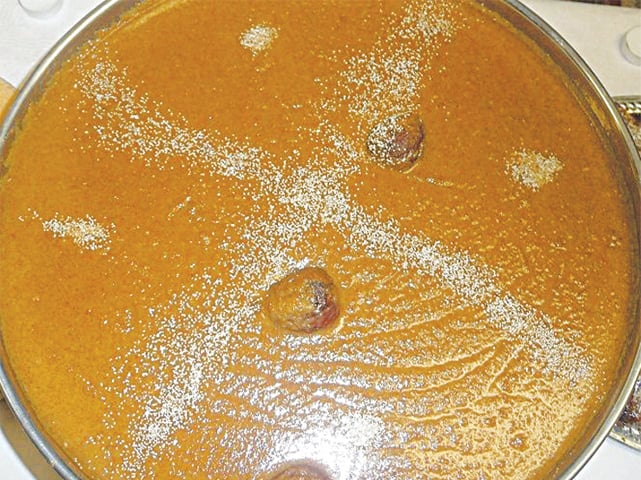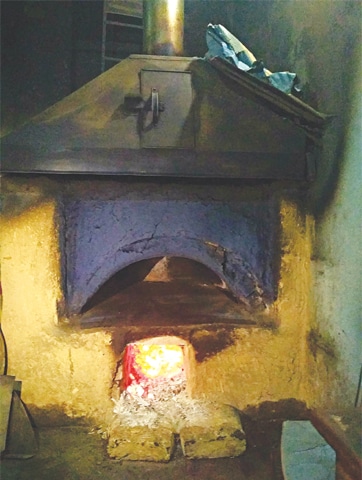
Afghan food is popular throughout Pakistan. Be it meat cooked to perfection in Afghani skewered botis and kebabs, aromatic Kabuli pulao or Afghani naan loved for its huge size and special texture and taste. But little is known about Afghani sweet treats and Afghan traditional cuisine is rich in sweetmeats.
Some of the more popular desserts are Brides Fingers (Asabia el Aroos), baklava, khatai cookies, firnee, sheer payrra fudge, gosh-i-feel (elephant ear pastries), kaddu bouranee, halwa-i-aurd-i-sujee and sabse borani.
If you happen to visit Quetta and are roaming the streets off Alamdar Road and nearby areas, you are sure to come across many interesting sweet shops where food items with interesting Persian names are being sold.
There is a lot more to Afghan food than just naans and kebabs
One of the famous Afghan delights is kulcha (Afghani cookies) which is not exactly the kulcha or naan that we see in Karachi and Lahore. This kulcha is really different from the tandoori one in other cities and is usually enjoyed with black or green tea.
“Kulcha has six different varieties which we sell here — the sweet variety, the savoury variety and then there is the mixture of savoury and sweet,” says Shabbir, one of the shop owners who, along with his father, has been in kulcha business for over three decades. “The basic ingredients for most of these are the same, i.e. white flour, sugar, salt, baking powder and oil mixed together. Cinnamon and nuts are added for variation in flavour. All these varieties are sweet. The savoury ones taste like saltish biscuits,” he adds.
“The odd one in all these varieties is called Biringee, derived from the Persian word for rice — Biring,” Shabbir points out. “It is made from pure, powdered rice instead of white flour, and sugar and oil.

“All of these when baked are garnished with sesame seeds and black seeds according to the customer’s fancy.”
Baked in wooden ovens, kulcha was invented by the Mongolians during the time of Changez Khan, from where it was transferred to a few parts of Afghanistan. “One of my friends who visited China told me that the Chinese also make the same sweet and saltish kulchas,” Shabbir says.
In addition to the above, there is the naan-i-roghani which is made from ground red wheat. “Another variety we used to make was bustakh, which was a kind of wholewheat, sweet naan but we stopped making them as they are no more in demand,” says Shabbir. “We also used to make laddu from wheat and some other sweets but, as per public demand, kulcha and naan-i-roghani are the best-selling items for Eid celebrations in these areas.
“Our best business is over the two Eids but people also place big orders for Nauroze. Nowadays, people are more interested in buying cakes and pastries for Eid,” says Shabbir.

Other kulcha sellers in the vicinity say that business is good and they get orders on a daily basis, as well as for special occasions. People travelling to other cities to meet their family take these delicacies along as gifts as you won’t find these treats in other cities.
The kulcha sellers maintain that the law and order situation in Quetta has affected business, otherwise they would still be getting orders from all over the province.
Another delight known as gosh-i-feel (Persian words meaning ‘ears of elephant’) and gosh-i-barra (meaning ‘ears of goat’) are also made among the Afghani families living on Alamdar Road and the surrounding areas. This sweet is not available in shops but is made by women at home.

In fact, gosh-i-feel and barra are the same thing named differently merely because of their shape. Both are made from white flour, sugar and oil. Turmeric powder is added to give it the characteristic yellow colour. After being fried in a mixture of sugar and oil, crushed pistachios and almonds are sprinkled on top. These delicacies are also made especially for Eid and Nauroze and are served to guests during these festivals.
Unfortunately these delights are restricted to certain areas and those preparing them feel that it is due to lack of media exposure here that these sweets have not been popularised. For someone visiting Quetta, these Afghan delights are a must-try.

Another famous delight made in Afghan homes is halwa-i-samanak — a sweet dish similar to pudding, which is made from wheat grain sprouted in a tray. This halwa is popular in Afghanistan, Iran and parts of Uzbekistan. The ingredients include barley wheat, wheat flour and sugar, all of which are ground and then cooked in desi ghee.
Preparing this dish is a long and tedious process which can easily take a day or two. The wheat is soaked and prepared for days. You need a sturdy fork to mash up all the ingredients manually. The ingredients are cooked on low heat in desi ghee until they turn brownish in colour. The final cooking lasts from evening till sunrise. Mostly when women do the cooking, there is a festive atmosphere. As a final step, the halwa is topped with crushed almonds or any other dry fruit/nuts available.
Published in Dawn, EOS, August 19th, 2018















































Dear visitor, the comments section is undergoing an overhaul and will return soon.